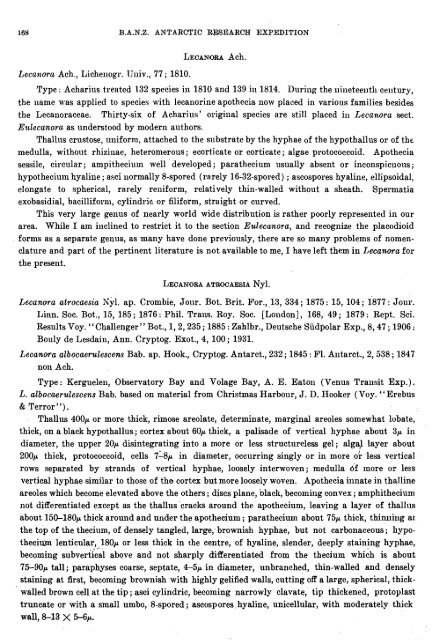Create successful ePaper yourself
Turn your PDF publications into a flip-book with our unique Google optimized e-Paper software.
168 B.A.N.Z. ANTARCTIC RESEARCH EXPEDITION<br />
Lecullora Ach., Lichenogr. Univ., 77; 1810.<br />
LECANORA Ach.<br />
Type: Acharius treated 132 species in 1810 and 139 i11 1814. During the riilleteeiith century,<br />
the name was applied to species with lecailorine apothecia now placed in various families besides<br />
the Lecanoraceae. Thirty-six of Acharius' original species are still placed in Lecunora sect.<br />
Ezslecanora as understood by modern authors.<br />
Thallus crustose, uniform, attached to the substrate by the hyphae of the hypothallus or of the<br />
medulla, without rhizinae, heteromerous ; ecorticate or corticate ; algae protococcoid. Apothecia<br />
sessile, circular; ampitheci~un well developed; parathecium usually absent or inconspicuous;<br />
hypothecium hyaline ; asci normally 8-spored (rarely 16-32-spored) ; ascospores hyaline, ellipsoidal,<br />
elongate to spherical, rarely reniform, relatively thin-walled without a sheath. Spermatia<br />
exobasidial, bacilliform, cylindric or filiform, straight or curved.<br />
This very large genus of nearly world wide distribution is rather poorly represented in our<br />
area. While I am inclined to restrict it to the section Eulecanora, and recognize the placodioid<br />
forms as a separate genus, as many have done previously, there are so many problems of nomen-<br />
clature and part of the pertinent literature is not available to me, I have left them in Lecanora for<br />
the present.<br />
LECANORA ATRQCAESIA Nyl.<br />
Lecanora atrocaesia Nyl. ap. Crombie, Jour. Bot. Brit. For., 13, 334; 1875: 15, 101; 1877: Jour.<br />
Linn. Soc. Bot., 15, 185 ; 1876 : Phil. Trans. Roy. Soc. [London], 168, 49 ; 1879 : Rept. Sci.<br />
Results Voy. "Challenger" Bot., 1,2,235 ; 1885 : Zahlbr., Deutsche Siidpolar Exp., 8,47 ; 1906 :<br />
Bouly de Lesdain, Ann. Cryptog. Exot., 4, 100; 1931.<br />
Lecanora a2bocaeru2escens Bab. ap. Hook., Cryptog. Antarct., 232 ; 1845 : F1. Antarct., 2,538 ; 1847<br />
non Ach.<br />
Type: Kerguelen, Observatory Bay and Volage Bay, A. E. Eaton (Venus Transit Exp.).<br />
L. a2bocaeru2escens Bab. based on material from Christmas Harbour, J. D. Hoolrer (Voy. "Erebus<br />
& Terror ' ') .<br />
Thallns 400p or more thick, rimose areolate, determinate, marginal areoles somewhat lobate,<br />
thick, on a black hypothallus; cortex about 60p thick, a palisade of vertical hyphae about 3p in<br />
diameter, the upper 20p disintegrating into a more or less structureless gel; algal layer about<br />
20OP thick, protococcoid, cells 718p in diameter, occurring singly or in more or less vertical<br />
rows separated by strands of vertical hyphae, loosely interwoven; medulla bf inore or lees<br />
vertical hyphae similar to those of the cortex but more loosely woven. Apothecia innate in thalline<br />
areoles which become elevated above the others ; discs plane, blaclr, becoming convex ; amphitheciunl<br />
not differentiated except as the thallus cracks around the apothecium, leaving a layer of thallus<br />
about 15&180p thick around and under the apothecium ; parathecium about 75p thick, thiniiirig at<br />
the top of the thecium, of densely tangled, large, brownish hyphae, but not carbonaceous; hypothecim<br />
lenticular, 18OP or less thick in the centre, of hyaline, slender, deeply staining hyphae,<br />
becoming subvertical above and not sharply differentiated from the thecium which is about<br />
75-90p tall; paraphyses coarse, septate, 4-5p in diameter, unbranched, thin-walled and densely<br />
staining at first, becoming brownish with highly gelified walls, cutting off a large, spherical, thiclrwalled<br />
brown cell at the tip ; asci cylindric, becoming narrowly clavate, tip thickened, protoplast<br />
truncate or with a small umbo, 8-spored; ascospores hyaline, unicellular, with moderately thick<br />
wall, 8-13 X 5-6p.

















